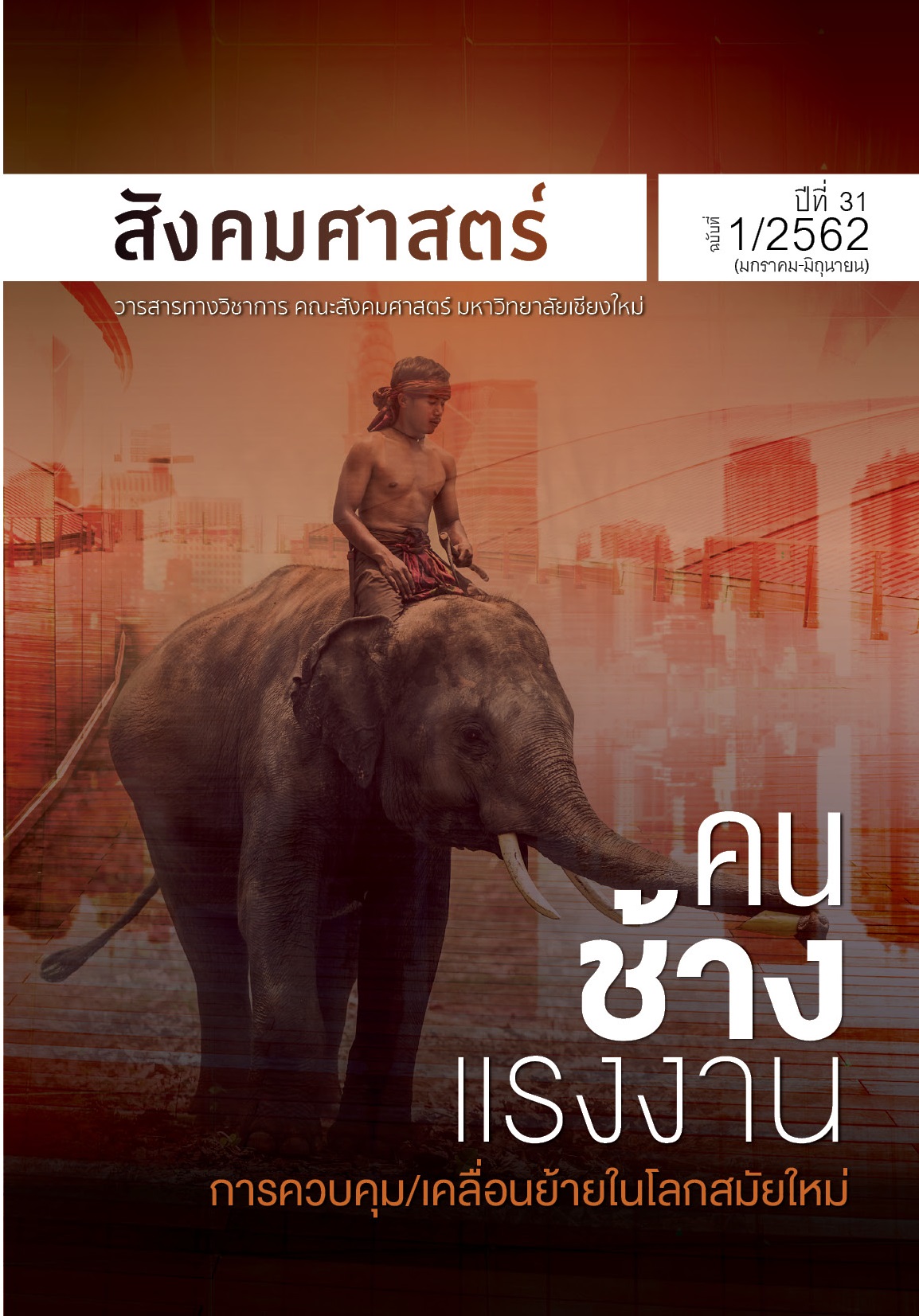Human/Elephant/Mobility and Nomadic Life in a Modern World
Main Article Content
Abstract
In Thai society human and elephant have long lived and interacted to each other for centuries. It is embedded in a social life of people, particularly in a mahout community. In some areas of northern and north eastern Thailand, a community raise and domesticate an elephant for its labor use. The mahouts who have knowledge and skills to capture this wild animal, domesticating and training these elephants for labor use. The intimated interactions between the mahouts and the elephants are reflected in their belief and ritual conducts. In this article we present a survey research finding, from the research project “Socio-economic profile of Thai mahouts in Thai tourism industry”, and additional ethnographic data from multi-sited fieldworks, conducted from August 2017 – April 2018, covering an elephant camp located in the 6 main tourism provinces of Chonburi, Phuket, Ayutthaya, Kanchanaburi, Surin and Chiang Mai. We will show that most of the mahouts who work in these elephant camps, although they are not owned the elephants, almost all of them have a cultural background from the mahout community, a traditional mahout. This group of Thai traditional mahout have engaged in elephant raising and training it for labor use. Whereas some other new groups, a mahout worker, who never involved with elephant raising before entering to the elephant camps, as a worker, particularly these mahout workers are a minority and cross border migrants. From the neighboring countries. Both groups of these mahouts, nevertheless, share together that they did not have a high modern education. Working as a mahout at the tourism elephant camps, however, requires a special skill, practical knowledge accumulated from experienced work and love and engagement with the elephants. The expansion of tourism based elephant camp business, in the famous tourist cities of Thailand, inevitably creates a new form of nomadic life among the mahouts in these modern days. These mahouts, the modern nomads we argue, must leave their home villages to work in the tourism based elephant camps, both in the main tourist cities of Thailand, such as Pattaya, Phuket, Chiang Mai, and in the foreign countries.
Article Details
All written articles published on Journal of Social Sciences is its author’s opinion which is not belonged to Faculty of Social Sciences, Chiang Mai University or is not in a responsibility of the journal’s editorial committee’s members.
References
จามะรี เชียงทอง และคณะ. 2554. ชนบทไทย. ภาควิชาสังคมวิทยาและมานุษยวิทยา คณะสังคมศาสตร์ มหาวิทยาลัยเชียงใหม่.
ชื่น ศรีสวัสดิ์ 2550. การท่องเที่ยวเชิงวัฒนธรรม : กรณีศึกษาวัฒนธรรมของชุมชนชาวกวยในเขตอีสานใต้และลาวใต้. รายงานวิจัยฉบับสมบูรณ์ ชุดโครงการการพัฒนาและจัดการท่องเที่ยวเชิงพื้นที่อย่างยั่งยืน กลุ่มจังหวัดอีสานใต้ สนับสนุนโดยสำนักงานกองทุนสนับสนุนการวิจัย.
ไชยวัฒน์ ปัญญานิติกุล. 2552. การศึกษาสภาวะปัญหาช้างเร่ร่อนในประเทศไทย. วิทยานิพนธ์วิทยาศาสตรมหาบัณฑิต สาขาวิชาสัตวศาสตร์ สำนักบริหารและพัฒนาวิชาการ มหาวทิยาลัยแม่โจ้.
ทองใบ ศรีสมบัติ. 2535. การเปลี่ยนแปลงวัฒนธรรมการเลี้ยงช้างและการประกอบอาชีพเลี้ยงช้างของหมู่บ้านช้างจังหวัดสุรินทร์. วิทยานิพนธ์ศิลปศาสตรมหาบัณฑิต สาขาไทยคดีศึกษา บัณฑิตวิทยาลัย มหาวิทยาลัยมหาสารคาม.
เภา บุญเยี่ยม และ ภารดี มหาขันธ์. 2558. ปะคำ: วิถีชีวิตและการดำรงอยู่ของคนเลี้ยงช้างภายใต้พลวัตการเปลี่ยนแปลงทางสังคมและวัฒนธรรม. วารสารวิชาการมนุษยศาสตร์และสังคมศาสตร์ ปีที่ 23 ฉบับที่ 41 (มกราคม-เมษายน 2558) : 101.
มีชัย แก้วหอม. 2554. โครงการวิจัยเรื่องศึกษาสถานการณ์ปัญหาและการแก้ไขปัญหาช้างเร่ร่อน กรณีศึกษา : ชุมชนคนเลี้ยงช้าง บ้านขุนไชยทองตำบลหนองเรือ อำเภอชุมพลบุรี จังหวัดสุรินทร์. สนับสนุนโดยสำนักงานกองทุนสนับสนุนการวิจัย.
รักษพล สกุลวัฒนา. 2538. คนเลี้ยงช้างชาวไทยกวยจังหวัดสุรินทร์. วิทยานิพนธ์สังคมวิทยาและมานุษยวิทยามหาบัณฑิต สาขามานุษยวิทยา มหาวิทยาลัยธรรมศาสตร์.
สมหมาย ชินนาค. 2539. ผีปะกำ: คติความเชื่อเรื่องผีบรรพบุรุษของชาวไทย-กวย (กวย) เลี้ยงช้าง จังหวัดสุรินทร์. วิทยานิพนธ์มานุษยวิทยามหาบัณฑิต ภาควิชาสังคมวิทยาและมานุษยวิทยา บัณฑิตวิทยาลัย จุฬาลงกรณ์มหาวิทยาลัย.
Evan Pritchard. 1940. The Nuer: A Description of the Modes of Livelihood and Political Institutions of a Nilotic People. Oxford. Clarendon Press.
Fredrik Barth. 1961. Nomad of South Persia: The Basseri Tribe of the Khanseh Confederacy. Oslo University Press.
Gilles Deleuze. 1986. Nomadology: The War Machine. New York, United States. AUTONOMEDIA.
Pierre Castles. 1972. Society Against the State: Essays in Political Anthropology. ZONE BOOKS.


